SWE's Rockin' Engineering Round Robin Tells Girls: "You Can Be An Engineer and Still Be Yourself!"

An Engineering Round Robin high school student explains a concept to her teammate about the protective eyewear they're designing during the "Protect Those Eyes!" session.
October 17, 2016
SWE’s (Society of Women Engineers) Engineering Round Robin, an outreach designed to expose girls to the different engineering disciplines, isn’t just for high school girls any more. Of the 45 girls who converged on Illinois’ Siebold Center on Saturday, October 8th, 20 were middle school students. Also different from past years was the interdisciplinary emphasis. Not only cutting across engineering disciplines, the program had a hint of STEAM (STEM + Art = STEAM). The goal? To show girls that they could become engineers and still be themselves.
New to the event this year was the inclusion of middle school students. According to SWE Co-Outreach Coordinator Molly McGiles, event planners combined high school and middle school girls to “create a more unique experience where the girls are learning the same materials, but doing them at a different level.”
Why open up the event to younger students? For one, so the high school girls can serve as mentors and role models to the younger girls. The goal was for the high school girls to help the middle schoolers, plus to allow the middle school girls to “see high school girls who are still interested in engineering in high school and they can help to keep them interested... and to be a role model for them.” The two age groups were separated for the hands-on activities, which were made more or less complex depending on the age group. For other parts of the day’s events, such as for lunch, ice breakers and team-building exercises, both groups were together.
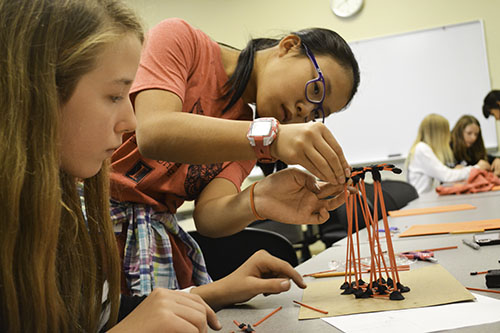
Engineering Round Robin participants work on their straw and clay structure during the Seizmic Shakeup !
In addition to the inclusion of younger students, several other program changes were implemented in the fall 2016 Round Robin. In the past, the girls had rotated through separate hands-on activities emphasizing each engineering discipline, then had done a separate design challenge. But McGiles says that the goal was to make the event more like what real engineers experience. So they combined the two and had the girls go through the design process while doing the hands-on activities. “We really wanted to combine them this year, so that they understand that when they’re in the field, they’re doing both at the same time.” So, instead, the girls rotated through three different activities focused on the interdisciplinary aspects of engineering.
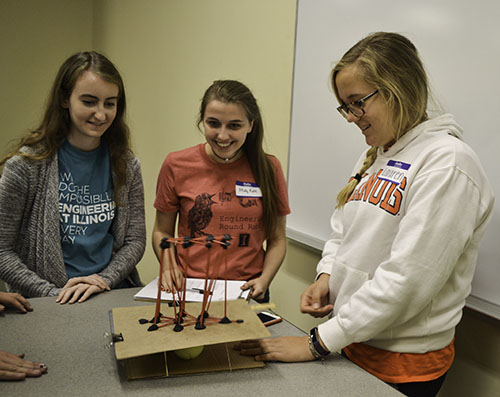
During Seizmic Shakeup, Illinois Engineering students, Lauren Grove, Molly McGiles, Lauren Excell, shake a team's revamped structure on the earthquake board to see if it will stand the test. (It did.)
Seizmic Shakeup! During this activity, which emphasized Mechanical, Civil, Environmental, and Aerospace Engineering, the girls used modeling clay, straws, and other materials to design a tower that could withstand an earthquake! The goal: to see how tall a skyscraper they could build that wouldn’t fall apart when shaken on an earthquake table.
SWE co-outreach coordinator, Molly McGiles, who had built and tested a structure during a dry run prior to the event, confesses: “I tested it on the Seizmic Shakeup table, and when I shook it, my structure fell, and I thought I spent a lot of time on it!” (Luckily for McGiles, she’s in Chemical Engineering, not Civil.)
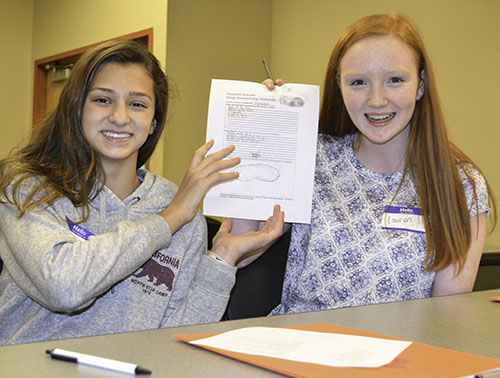
Students in the "Protect Those Eyes!" workshop show the protective eyewear design they created.
Protect Those Eyes! For this activity, which featured Biomedical, Chemical, and Materials Science Engineering, the girls designed protective wear, such as safety goggles, for their eyes, Then they wore them to do an experiment where they turned milk into plastic.
Binary Numbers and Arduinos. In this activity, the girls learned about Electrical and Computer Engineering and Computer Science. The goal was that they “learn to speak in binary and use binary code,” explains McGiles, “and then they make their bread board, and they program it to be able to send messages to a friend across the room.”
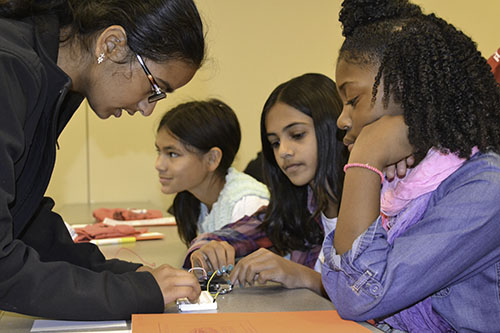
A Illinois Engineering student (left) helps some middle school students trouble shoot their arduino.
In addition to the interdisciplinary emphasis on engineering, the goal was to make the event even more broadly interdisciplinary. While still considered STEM outreach, the program gave a nod to STEAM this year. (All the rage in the STEM world, STEAM (Science, Technology, Engineering, Arts, and Mathematics) adds “arts” to the mix.
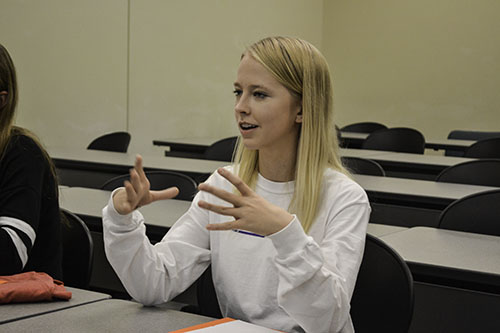
A Seizmic Shakeup participant explains the design process she and her team went through and how they improved their prototype the second time around.
Thus, the theme for this year’s event was Rockin’ Robin; teams had names like “Hip-Hop Pop” and “Rock & Roll,” plus each activity had a sentence or two that tied it into the arts. “STEAM is starting to take off,” McGiles admits, “and though our main focus is STEM, we wanted to show a little glimpse of how STEAM can be incorporated. So focus it on STEM, but show how that “A” is sneaking in there.”
According to McGiles, a junior in Chemical Engineering this fall, the interdisciplinary emphasis was to show the girls that they can become engineers and still be themselves.
“We also wanted to incorporate all of what engineering is. I’m not just an engineer.”
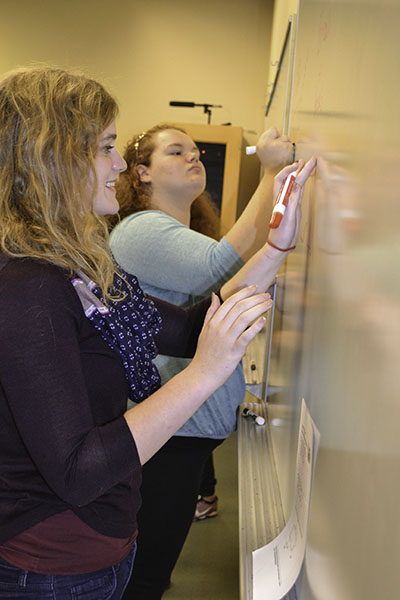
Round Robin participants draw their protective eyewear design on the whiteboard.
McGiles goes on to explain that she’s been a dancer since she was little, and she loves music.” And I love my social media and my pop culture,” she adds. “We just want to show the girls that there’s more to being an engineer than just being an engineer. You’re still you; you don’t have to give up “you” to be an engineer.”
She adds that one of the goals of the interdisciplinary emphasis was to show the girls that their other interests can still be incorporated into an engineering career. “You being an engineer is still you being you. You don’t have to decide, ‘Oh, I’m going to be an engineer or I’m going to be an artist.’ You can kind of be both.”
She indicates that other non-engineering-related skills are still important, too. For example, engineers often have to write descriptions of things, so they must call on their English skills. Or at times, a project requires that they draw something, for which their artistic skills would come in handy.
Why all the changes to Round Robin, now in its third year? “We’re trying to be really different. We do these engineering events all the time, and they’re really successful, but we want to adapt them more, change them up a little bit.”
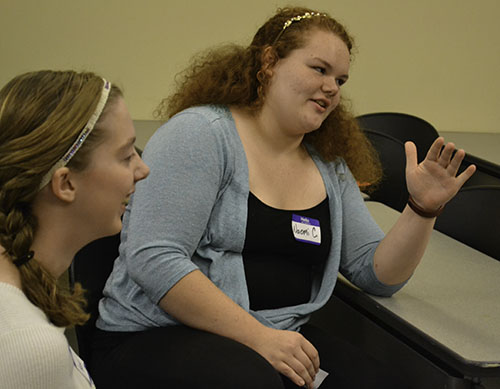
During an ice breaker, a student explains why she deserves to remain on a too-small lifeboat. (Her very creative spiel? She was a grandmother taking care of three quite needy grandchildren.)
The new twist on the event that McGiles was most excited about, was…lunch. For starters, as an icebreaker, from a list of things on the board, the girls found someone who had something in common with them to be their “buddy.” Lunch also featured a student panel, so girls could get answers to their questions about engineering and what being a student at Illinois is like. Plus, girls participated in some team-building activities.
“So it makes lunch a learning experience,” explains McGiles. “It’s not just, you’re coming in, and you’re eating your food, and then you’re going back to learning. It continues the learning process.”
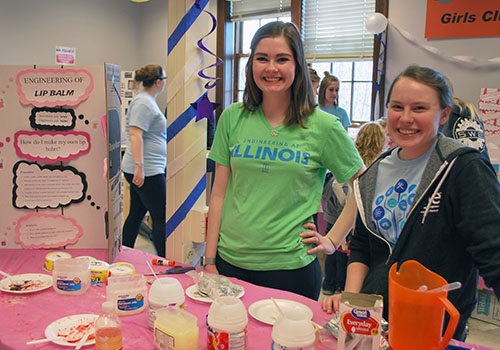
Co-SWE Outreach Coordinator Abigail Gerth (right) helps with the Lip Balm activity in SWE's room during EOH 16. (Photo courtesy of Abigail Gerth.)
So what kind of impact did Round Robin seem to have on the participants? Abigail Gerth, SWE's other 2016–2017 Co-Outreach Coordinator, reports that the middle schoolers definitely "seemed engaged throughout the activities." She adds that she was "really impressed with their creative solutions to the design challenges. They seemed to like working together in groups."
What about the highschoolers? Does Gerth believe the event impacted their choosing engineering careers?
"I definitely think the girls got something out of it. I think the longer activity rotations gave them an opportunity to ask more questions about the specific majors and really get to know what each one was about."
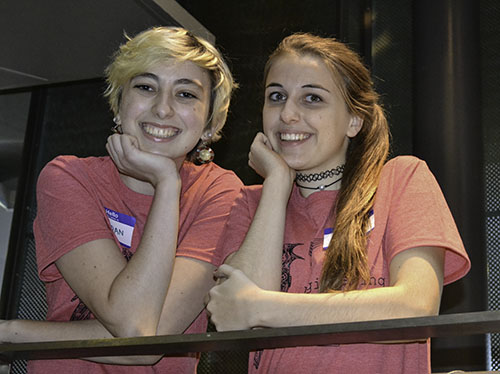
Left to right: Illinois Engineering students Meridan Markowitz, the Engineering Round Robin Chair Coordinator, and Molly McGiles, a SWE Co-Outreach Chair and Round Robin Director.
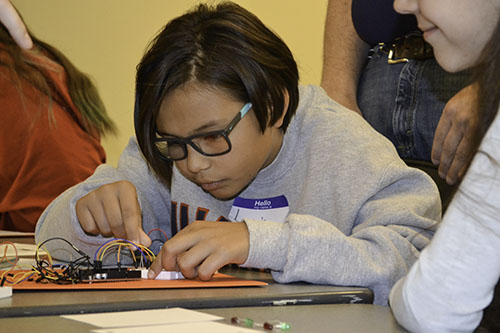
A middle school student learns about electrical engineering during the "Binary Coding and Arduinos" activity.
Why does McGiles spend so much time on outreach? For one, she loves engineering. “It doesn’t feel like it’s a lot of extra time; it just feels like it’s an extra part of my school life being here, because it’s something I’m so passionate about.”
One reason she’s so passionate is because of the impact it had on her personally.
“The only reason I’m in Engineering at Illinois is because of an outreach event that I went to here when I was in middle school and in high school. I came to Illinois’ campus for an outreach event over the summer. It was a camp, and I came, and I fell in love with engineering.”
In fact, she wasn’t even going to study engineering; she intended to study American sign language interpreting: “And then I went to this program, and I fell in love with engineering, and I fell in love with Illinois, and I just want to share that passion back with everyone.”
Like McGiles, Gerth also considers outreach an opportunity to give back. "I've always loved kids and loved helping people, and Outreach gives me an opportunity to do both on pretty much a daily basis. Seeing girls' faces light up as they explain to me the design they are working on is such a rewarding experience."
Story and photos by Elizabeth Innes, Communications Specialist, I-STEM Education Initiative
More: 6-8 Outreach, 8-12 Outreach, Engineering, Society of Women Engineers, Women in STEM, 2016
For additional I-STEM web articles about SWE and its outreach events, see:
- SWE's "Save the World With Engineering" Outreach Targets Middle School Girls
- Introduce-a-Girl-to-Engineering Day Tells Girls: "You Can Be an Engineer, Change the World!”
- Mommy, Me, and SWE Strives to Convince Girls That They Can Be Engineers Too
- Leal Kindergarteners Are “Engineers-in-Training” Thanks to SWE’s FKO Outreach
- SWE Outreach Seeks to Interest Kids in Engineering and Say, “You Can Do It Too!”
- SWE: A Support System for Illinois' Female Engineering Students
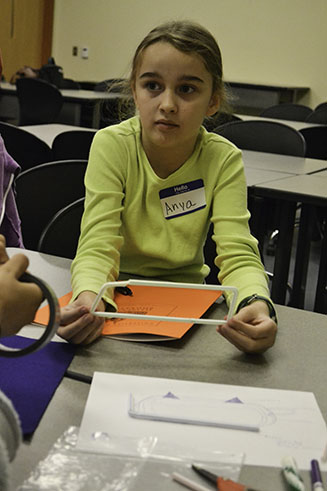
A middle school student works on her team's protective eyewear design during the "Protect Those Eyes! workshop.
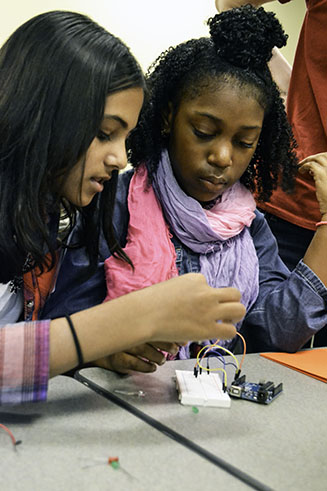
Two middle school students make a circuit during the "Binary Numbers and Arduinos" workshop.
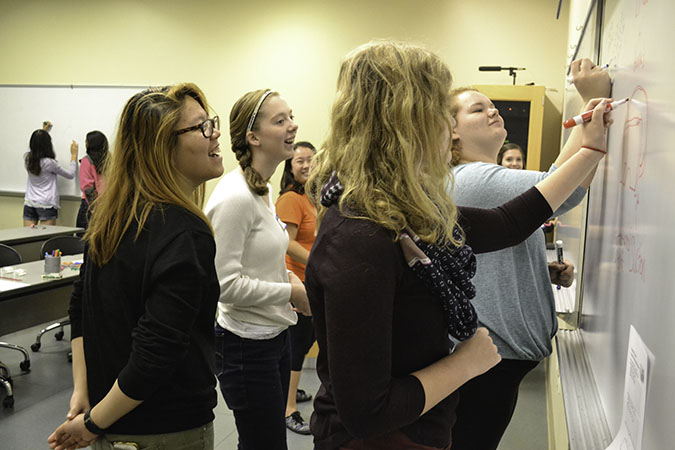
High school students draw an image of their prototype on the whiteboard during Engineering Round Robin's "Protect Those Eyes!" activity.













.jpg)
















